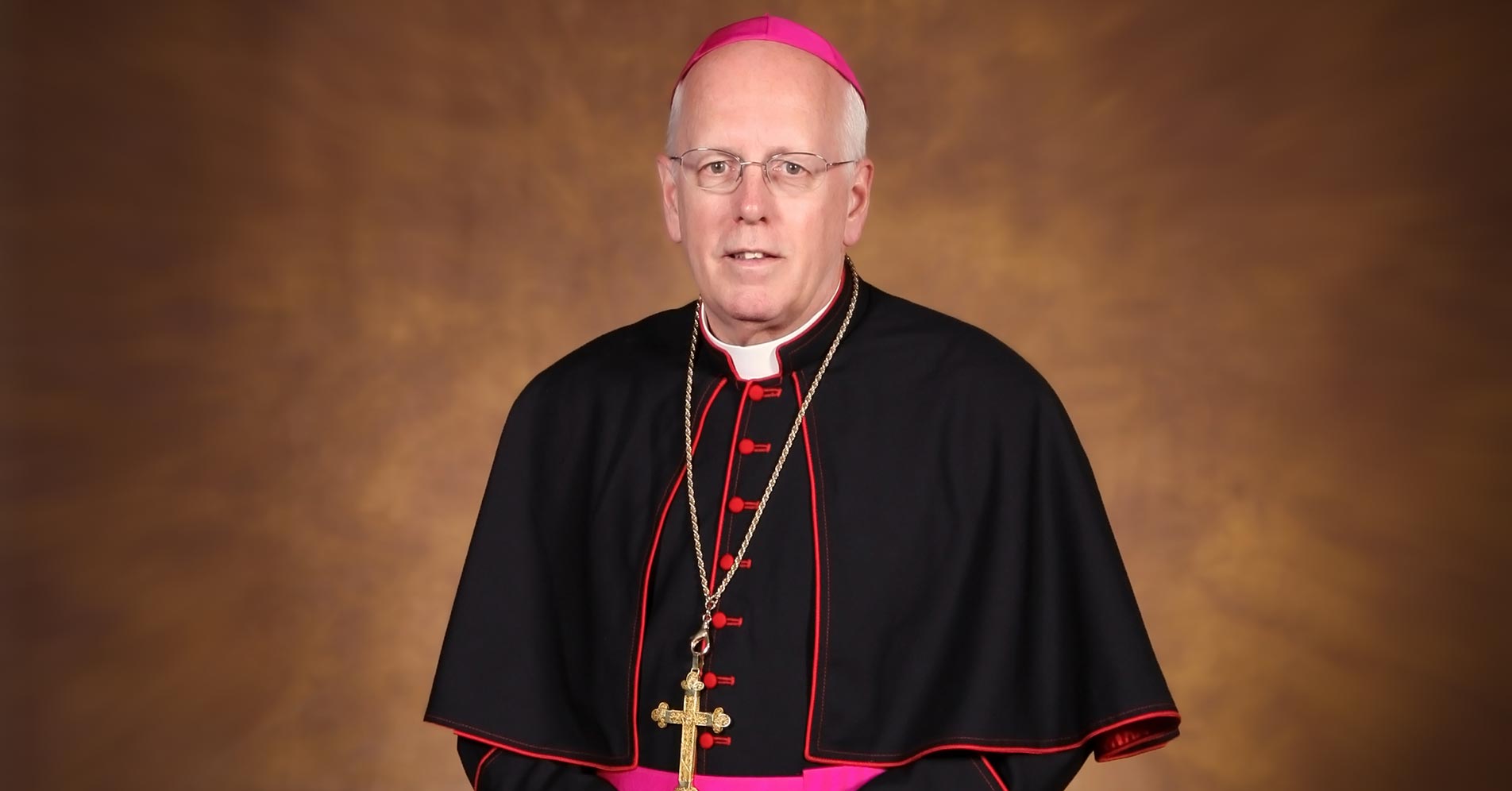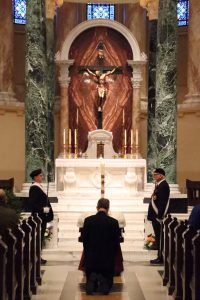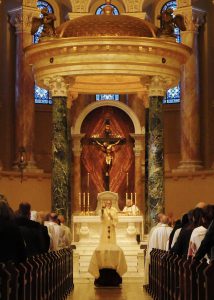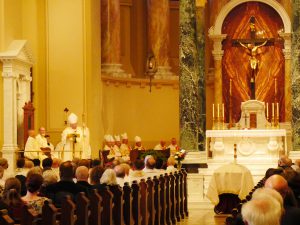
The Most Reverend Paul J. Swain passed away Nov. 26, 2022, while in hospice care at Dougherty House in Sioux Falls. He was 79 years old.
A Mass of Christian Burial was celebrated Dec. 3, 2022, in the Cathedral of Saint Joseph. Burial was at St. Michael Cemetery in Sioux Falls.
Bishop Swain served as the eighth bishop of the Diocese of Sioux Falls from Oct. 26, 2006, to Feb. 13, 2020, when he was succeeded by current Bishop Donald DeGrood. During his time in the diocese, Bishop Swain oversaw the restoration of the Cathedral of Saint Joseph, the creation of the Bishop Dudley Hospitality House, the building of the permanent home for the Adoration Sisters of the Blessed Sacrament, and the celebration of the 125th anniversary of the diocese, among many other accomplishments.
Father Charles Cimpl, who served under Bishop Swain as vicar general, knew him well and witnessed his deep faith.
“Bishop Swain wasn’t a cradle Catholic, so his love for the Holy Eucharist was never taken for granted,” Father Cimpl said. “His experience of the fire in the cathedral in the Diocese of Madison while he was the rector (before becoming a bishop) deeply influenced that love. That experience assisted in his leadership in restoring our cathedral as he wanted it to reflect the beauty of the Body of Christ.”
Father Cimpl has many fond memories of Bishop Swain, but one in particular defined him as a bishop early on in his service to the diocese.

“After Bishop Swain was introduced to the Chancery staff in Sioux Falls when he was announced as our new bishop, he asked me to drive him around the city since he had never been here,” Father Cimpl said. “We went by all the Catholic parishes in the city, and when we arrived at the first one, I asked him if he wanted to stop in and meet the staff. He replied, ‘No, I always felt like when the bishop just stopped, it was a disruption.’ In many ways, that was his leadership style. He didn’t want to disrupt but lead by his example of humility, his love of the Lord and his service to God’s people.”
Bishop DeGrood took great comfort in taking the reins in a diocese led well under Bishop Swain before him.
“I give thanks to God for the humble servant leadership Bishop Swain provided to all the people in east river South Dakota,” Bishop DeGrood said. “His love for God and those he served has left a legacy of collaborative efforts within the Catholic communities and among community leaders. It is my hope and prayer that as we recall the gift of his life and ministry as a bishop, we will remember him in our prayers.”
Paul Joseph Swain was born Sept. 12, 1943, in Newark, New York. He was the son of William E. and Gertrude (née Shawcross) Swain. Paul was the fifth of six children. He and his siblings were raised by their grandparents.
As a child, Paul received his religious formation in the Methodist Church. In high school, he first aspired to be an attorney and took an interest in the political process. He graduated from Newark High School in 1961.
He enrolled at Ohio Northern University in Ada, Ohio, where he studied history. He moved to Madison, Wisconsin, in 1965 and enrolled at the University of Wisconsin-Madison to pursue a master’s degree in political science.
Upon completing his master’s degree, Paul voluntarily entered military service as an intelligence officer in the U.S. Air Force. This service included time served in Vietnam during the Vietnam War, where he earned a Bronze Star. After his military service, Paul returned to Madison and enrolled in the University of Wisconsin’s law school. In 1974, he was awarded his juris doctor degree and began a private practice in law.
In 1978, Paul became involved with the gubernatorial campaign of a newcomer to the political scene, Lee S. Dreyfus. Upon Dreyfus’ election as governor, he asked Paul to serve as his legal counsel and director of policy. As this role came to an end, the thought of becoming a priest entered Paul’s mind and heart in ways such that it would not leave. This, of course, was rather curious since he was not yet a Catholic.
After receiving instruction in the Catholic faith, Paul was confirmed and received his first Holy Communion at Holy Redeemer Church in Madison at Easter Vigil in 1983. Later that summer, he enrolled at Pope St. John XXIII Seminary in Weston, Massachusetts, as a seminarian for the Diocese of Madison and was ordained May 27, 1988.
Father Paul Swain held many appointments for the Diocese of Madison, including vocations director, moderator of the curia, priest secretary and vicar general, the last a role he would hold for two different bishops. His pastoral work included stints at Sacred Hearts of Jesus and Mary in Sun Prairie, St. Mary in Pine Bluff, St. Bernard in Middleton, St. Patrick and Holy Redeemer in Madison, and as rector of St. Raphael Cathedral. In June of 1998, Father Swain was elevated to monsignor when Pope John Paul II appointed him as a prelate of honor.

On Aug. 31, 2006, Pope Benedict XVI appointed him as bishop of Sioux Falls. He was ordained and installed as the eighth bishop of the diocese by Archbishop Harry Flynn on Oct. 26, 2006, an office he would serve in until being succeeded on Feb. 13, 2020. During his time in office, Bishop Swain ordained 32 men to the priesthood and 20 men to the permanent diaconate.
Bishop Swain led the diocese in a restoration of our Cathedral of Saint Joseph, elevating this civic and sacred landmark by bringing forth its beauty as envisioned by the original architect. Addressing Mass congregants on the day he dedicated the new altar that was installed, Bishop Swain shared,“(I)t is my prayer that this restored cathedral will be a shining light on the hill outside and in, by the beauty of sacred things and by the beauty of faith lived well, can therefore be a sign of the hope that can only be fulfilled in Christ. And so we invite all to come here on pilgrimage and to seek to satisfy the yearning for the holy, to discover meaning in the midst of trial, even fear, and to experience the peace that comes from knowing Jesus Christ as Lord, Savior and friend.”
A noteworthy part of the restoration was that it led to a church that was well-equipped to host the televised Sunday Mass, a liturgy that became a priority for Bishop Swain. As a result, the TV Mass became an important way by which Bishop Swain sought to connect with the faithful of our diocese personally through both liturgy and our mother church.
Responding to a dire need of the city of Sioux Falls, Bishop Swain oversaw the creation of the Bishop Dudley Hospitality House, an emergency shelter for individuals and families. At its blessing and opening, Bishop Swain described the new facility as “more than a shelter, it will be a Beacon of Hope, a house of hospitality that welcomes, that treats each person with respect, that seeks to help address special needs, that offers a helping hand, that says you matter and that sees Christ in each person with wisdom of the heart, that calls each person by name.”
As bishop, he blessed eight different properties in six communities that were erected by St. Joseph Catholic Housing to provide affordable housing for families. He spent time praying the Rosary in front of Planned Parenthood every month he served as bishop, save for the time when he suffered a medical event. Joining Bishop Robert Gruss of Rapid City, he created the South Dakota Catholic Conference as a ministry to assist Catholics in their efforts to apply Church teaching in their daily lives. He also led an effort to erect a permanent home for the Adoration Sisters of the Blessed Sacrament, who pray continuously for the needs of the diocese.
Facing a decline in the number of available priests and the withdrawal of religious orders who were serving our diocese, Bishop Swain oversaw a consultative planning process that involved more than six years of listening sessions and facilitated meetings. In most of those churches that no longer saw regular Sunday liturgies as a result of the planning process and recognizing the grief that existed, Bishop Swain presided at Masses of Thanksgiving.

Nearing the point of his mandatory retirement, having grown fond of and cared for so many of the faithful he had encountered since his arrival in 2006, Bishop Swain proudly declared himself a South Dakotan and announced his intention to remain here in his retirement.
His episcopal motto, confitemini Domini (“give praise to the Lord”), was Bishop Swain’s way of expressing his lived belief that it is not what we do but how we conduct ourselves that matters most in the Christian life.
Bishop Swain was preceded in death by his parents and his five siblings and three of their spouses. He is survived by one sister-in-law.


